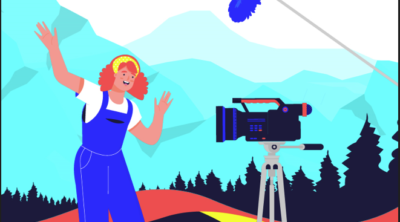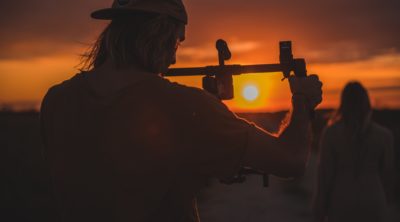< Back to all posts
A Beginners Guide to B-Roll Footage
- B-roll is comprised of the visual images which are displayed over the audio of interviews or narration.
- High-quality B-roll can facilitate the flow of your video while also enhancing its aesthetics.
- The acquisition of B-roll should be a top priority—not an afterthought—on any video shoot.
You’ll know if a marketing professional is clueless about video production if he or she says something like, “Just get interviews of him and her, grab some additional footage, and that’s all we’ll need.”
The problem is that this so-called “additional footage” is essential to the finished product. Good footage can enhance the quality of the video, while subpar footage can lose the viewer’s interest in a hurry. That’s why obtaining this extra footage—known in the video production industry as “B-roll”—is as important as recording the interview itself.
What Exactly IS B-Roll?
The term “B-roll” originated prior to the invention of video when movies were being shot on 16-millimeter film. Editing these projects was complicated by the fact that the splices between strips of film were visible during playback.
Moviemakers solved this problem by affixing black “leader” (film strips without images on them) behind the film splices. This was done in such a way that the odd-numbered shots (the “A-roll”) and the even-numbered shots (the “B-roll”) were matched by black leader in a “checkerboard” pattern.
These days, B-roll refers to the visual images which are inserted into a video while an interview is taking place. Usually, the audio of the interview is heard while the B-roll footage is seen.
Most people perceive B-roll to be purely utilitarian in nature. Certainly, B-roll is commonly used in video editing to:
- Provide images while a narrator’s voice is heard in the video
- Hide a visual splice between two non-contiguous interview segments
- Hide a splice which removes superfluous speech from an interviewee’s response (like stumbles and “uhs”)
- Illustrate the subject matter the interviewee is discussing
- Provide shots which establish the location or setting of the video’s subject matter
- Provide background images over which graphics, logos, or text is displayed
What B-Roll Can Do
A skilled director or producer will also employ B-roll to improve the aesthetic of the video. That’s why it’s vital that marketers put some serious thought into what B-roll is needed for the video so that it can be obtained on the day(s) when the interview or videography takes place.
At a minimum, the B-roll should augment the audio of the interview segment or the overall topic of the video. But B-roll shots can also play a role in the ambiance of the project.
For example, a video promoting a tropical travel destination would probably include slow pans of beautiful vistas or beaches in the hopes of creating a sensation of relaxation and tranquility. In contrast, a video showcasing a modern dance troupe might contain quick shots and fast camera movements of dancers practicing or performing in order to build excitement and anticipation.
There is an infinite number of possibilities for B-roll shots for a video. Some of the most common images include:
- Outdoor shots of a building or facility
- Machinery working or moving products
- Two or more people talking with one another or interacting in a meeting
- People using tools
- People working at computers or reading documents
- Equipment or machinery being turned on or off
- People holding something and showing it to the camera
- Framed awards, photos, collectibles, or unique objects sitting on a shelf or in a display case
- Vehicles moving toward or away from camera
- People walking into or out of a building
- Signs displaying warnings, directions, or names of places
- Interior details of a setting or location
- Nature vistas or wide shots of cities, freeways, or land
- Any object or activity that most people would consider unique
You should also collect B-roll of the interview itself, such as:
- Footage of the interviewee working, talking on the phone, or conversing with colleagues
- “Cutaway” shots of interviewer nodding, smiling, or reacting to the interviewee
- Close-up shots of the interviewee’s hands or what he or she is holding
- Shots of the interviewee’s work environment
Don’t Make B-Roll an Afterthought
Unlike the sentiment of the inexperienced marketer, it’s imperative that a great deal of thought must go into what kinds of B-roll shots are needed for the video long before the day of the interview shoot. In fact, many producers like to allocate an equal amount of recording time for both an interview and any accompanying B-roll.
In many cases, B-roll may even be prioritized higher than the interview itself. For example, if a certain event or occurrence only happens at a specific time each day (like the sun rising over a company’s headquarters, the CEO giving a presentation to employees, or the assembly line being turned on to start a shift), then it’s wise to schedule the interview around it.
It’s also a good idea to divide intended B-roll shots into “must-haves” and “nice-to-haves.” That way, you can make sure that the mandatory B-roll footage is captured before the shoot day is over instead of wasting time trying to get “artistic” footage and neglecting to record the basic “informative” shots.
Other B-Roll Options
Finally, it’s important to keep in mind that B-roll for your particular video doesn’t have to come exclusively from the collection of footage shot on the day of the interview. If you’ve previously produced a video for your company, you may already have some excellent images of material that’s relevant to your current one. That’s why it’s wise to carefully catalog every minute of footage shot on a particular project – not just the shots which end up being used in a video.
Also, it may be easier to obtain specific shots from another source if you can’t procure it yourself. There are plenty of companies who will sell short clips or comprehensive volumes of video footage to you for a small fee. There are websites that offer royalty-free footage you can utilize as well. While creating your own content is always preferred these are alternatives when time or budget constraints prevent you from getting a shot.
It’s also possible to make use of artificially-produced material for B-roll. Text slides, graphics sequences, and animations may be more appropriate and enlightening for a specific topic than conventional video shots. Just be aware that too much of this style of footage might be visually uninteresting to your target audience.
If you’re ever unsure of what type of B-roll would work well for a specific project, you can always partner with an experienced video producer who can make valuable suggestions about the shots that will boost the appeal of your video. But you should never overlook or de-emphasize the need for relevant, visually-appealing B-roll when creating a marketing video that highlights your brand, promotes your products or services, and ultimately increases your company’s revenue.
Need some specific B-roll for a project? Get a quote from us today!







https://crewscontrol.com/ thanks for the information